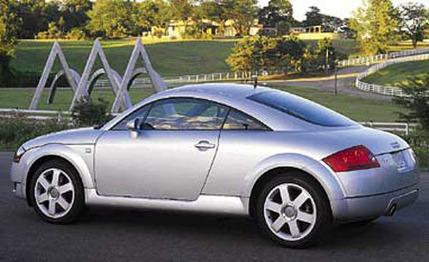 Short Take Road Test
Short Take Road Test
The Audi TT Quattro is like the latest, greatest Swiss Army knife: the SwissChamp model, the one with 33 features, including the fish scaler and hook disgorger.
And like the quirky, classic red pocket knife, it is probably overqualified for most everyday chores.
The new TT Quattro, an architectural rhapsody of circles and arches in which the promise of its artistic form is paid off in full, both outside and inside the car, is a three-door, two-plus-two sports coupe that is the ultimate gadget.
Underpinning it is a new variation on Audi's 19-year-old Quattro concept. This Quattro IV all-wheel-drive system features a unique electrohydraulically controlled torque-distribution system that redirects traction to whichever wheels have the most grip--within 25 centimeters of first slippage. It replaces the familiar Torsen center-differential setup on all Quattros with longitudinally mounted engines. The TT Quattro's engine, positioned transversely, is the same 180-hp, 1.8-liter five-valves-per-cylinder four-banger found in the front-drive TT.
Acceleration, not surprisingly, suffers somewhat due to the added weight and friction of the Quattro system. But superior traction and improved weight distribution (60/40 versus 62/38) ensure a good launch. These keep the Quattro within 0.2 second of the front-driver through the quarter-mile, but an extra 298 pounds in this Quattro lowered our trap speed by 5 mph for a 15.8-second, 85-mph time. Skidpad numbers were close, with the Quattro scoring just 0.01 g behind the front-driver at 0.86 g.
Fuel economy suffers slightly for the Quattro--about 2 mpg across the board. But the Quattro's range is about five percent better, due to a gas tank that carries 1.8 more gallons than the front-driver's.
The Quattro hardware and multilink rear suspension package neatly under the rear luggage compartment, but luggage capacity is eroded by three cubic feet with the rear seats up, and by 5.6 cubes with them folded down. Which is where they should stay, as no one older than 10 or taller than Mini-Me will fit in the back seat anyway.
The exterior dimensions of the two cars are virtually the same--only wheelbase and rear track differ, and by just a few 10ths of an inch.
The differences are all functional, and they are significant. Our test of the front-wheel-drive TT coupe (June 1999) noted its "minimal torque steer." But it seems more than minimal after a comparison drive in the Quattro. The coupe's torque steer was apparent on hard acceleration across uneven pavement, on a diagonal railroad crossing, in straight-line first- and second-gear acceleration, in third-gear lane changing, and on unpaved roads.
The Quattro, on the other hand, was rock solid on all surfaces. Especially on our not-so-secret 10Best "test track," with its boy-racer rally-stage cutoff, which the Quattro positively had for lunch. Of course, these impressions might be out-of-date. Audi has redesigned the anti-roll bars and the front control arms to correct a high-speed-stability problem.
This car begs to be driven hard and even seems to sulk when it isn't. So, should you ignore the $31,025 front-drive coupe and bag yourself a Quattro for another $1750? Not necessarily. Both are extremely capable vehicles. The Quattro may even creep into the "overly capable" category. And before you set your heart on one of these two TTs, remember that this spring Audi will unleash a true two-seat-roadster variant as well as a 225-hp Quattro drivetrain option with a jumbo turbocharger, twin intercoolers, and a close-ratio six-speed transmission. That one should be capable of running 0 to 60 in the low-six-second range.
Which will be the automotive equivalent of having both a SwissChamp and a Leatherman hanging from holsters on your belt.